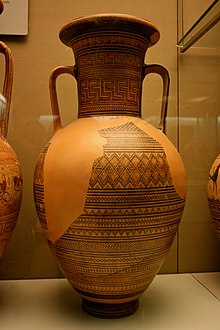Elgin Amphora

TheElgin Amphorais a largeAncient Greekneck-handledamphoramade from fired clay inAthensaround 760 to 750 BC. The ceramic vessel may have been used to hold wine at a funeral feast, and then entombed with the cremated remains of the deceased. Fragments have survived, decorated in the LateGeometric style,and attributed to an unknown artist given theNotnameof "theDipylon Master",one of the earliest individually identifiable Greek artists. The fragments have been restored to reconstruct a single but incomplete vessel, 67 centimetres (26 in) high, which is now displayed at theBritish Museumin London.
The amphora stands on a rim foot. The outer surface of its ovoid body is decorated with bands of geometric patterns, including repeated lozenges in a tapestry design around the widest part of the amphora, rows of triangles, and a chequered pattern on its shoulders. The tall cylindrical neck bears a doublemeander,and a frieze of water birds just below the rim. The strap handles are decorated with dotted serpents.
Fragments of the amphora were excavated in Athens byGiovanni Battista Lusieriin 1804–6. The exact find location is not known, but it was probably somewhere between theMouseion Hilland theRiver Ilisos.It was acquired byThomas Bruce, 7th Earl of Elgin.His descendants sold it to John Hewett before the 1950s, and it was then acquired by Hon Robert Erskine, the son ofJohn Erskine, Lord Erskine.A fragment was sold atSotheby'sin 1994, and later reunited with the other fragments which were bought privately. It was loaned to the British Museum, and then acquired by the British Museum in 2004 from the Trustees of theStanford PlaceCollection, using £40,000 provided byThe Art Fund,and funds from theWolfson Foundation,Alexander Talbot Rice,British Museum Friends, theCaryatid Fund,and theSociety of DilettantiCharitable Trust
References
[edit]- The Elgin Amphora,British Museum
- Elgin Amphora by Dipylon Workshop, Athens,Art Fund
- Elgin Amphora[dead link],Google Arts & Culture
